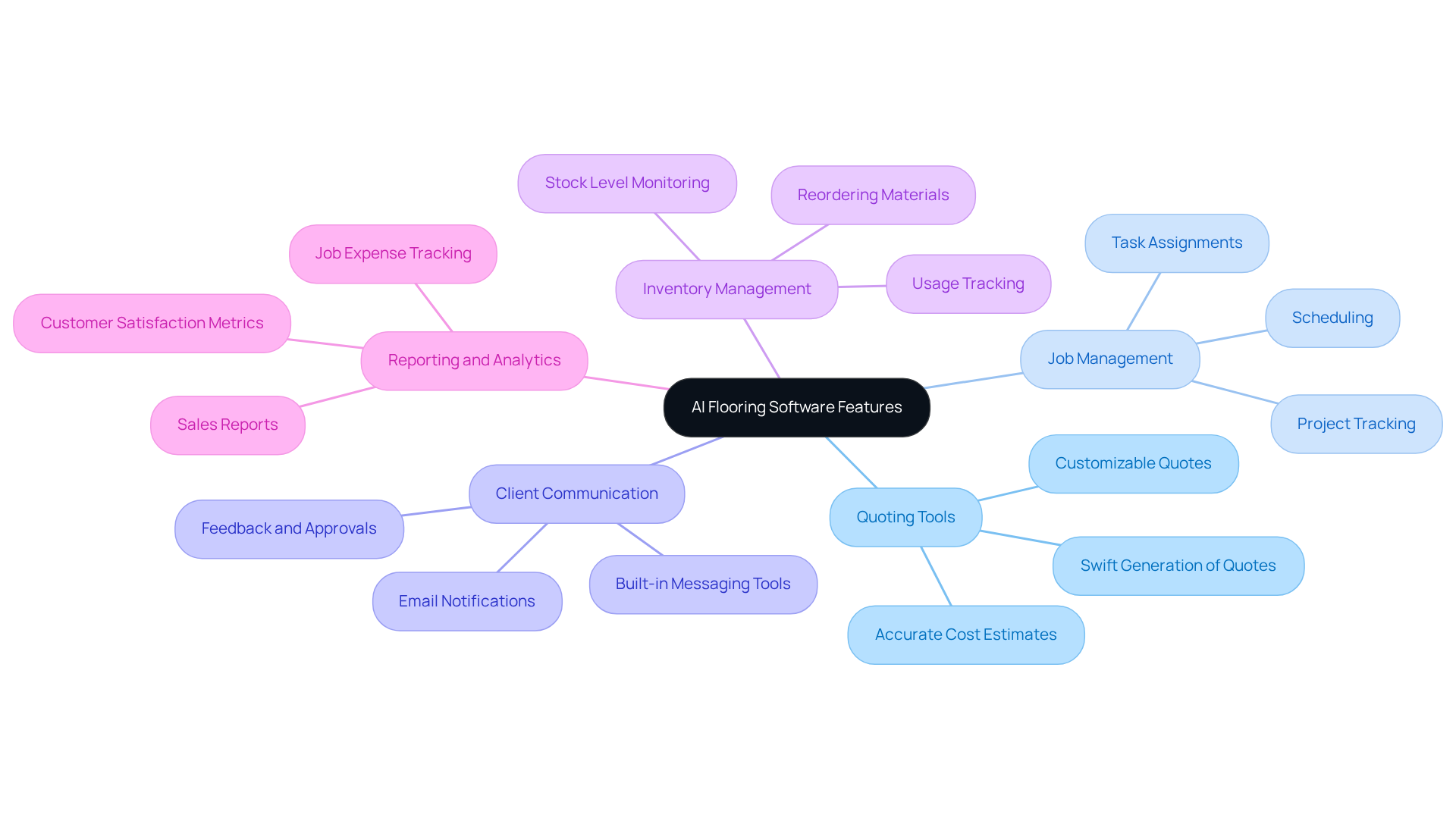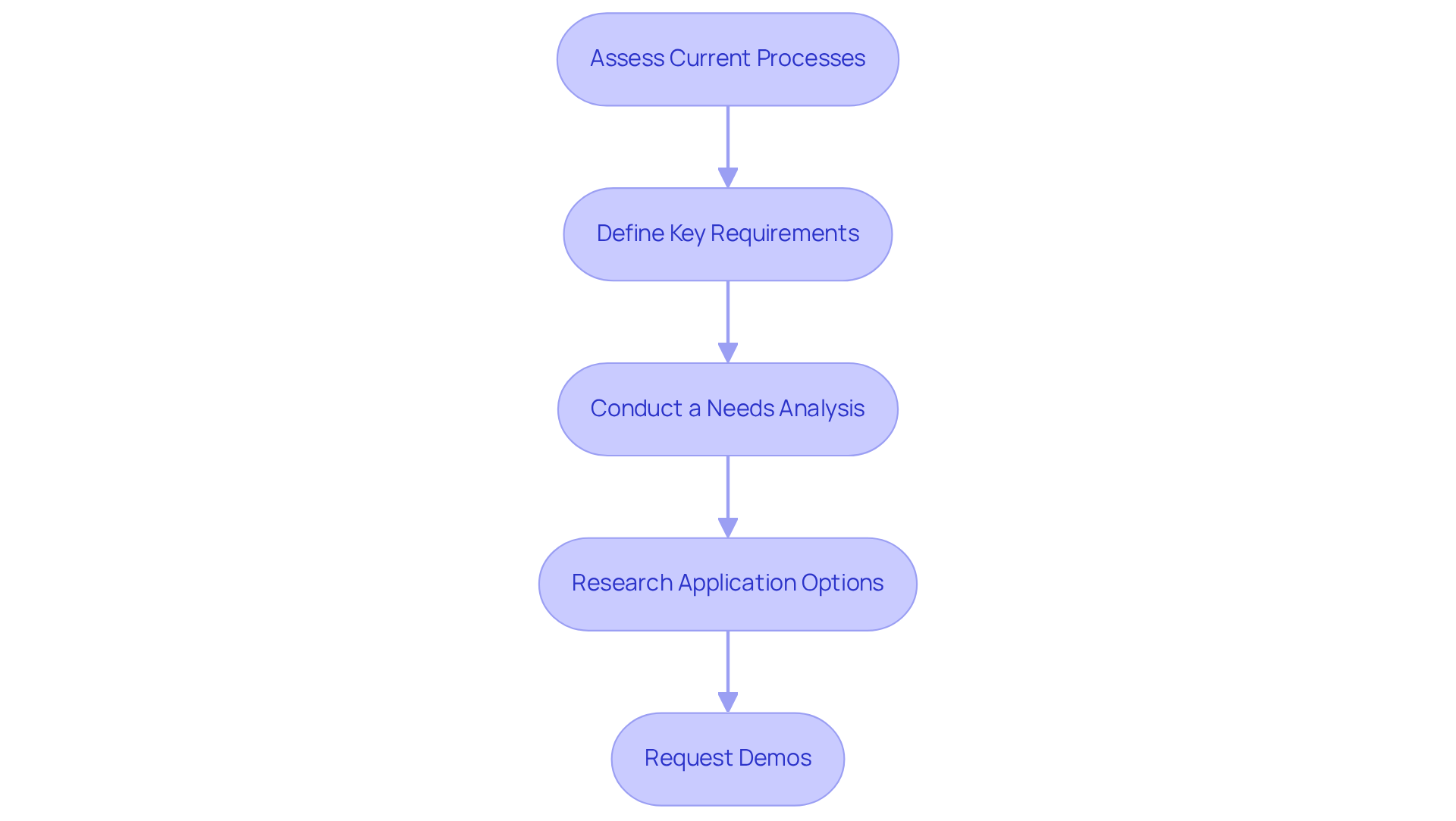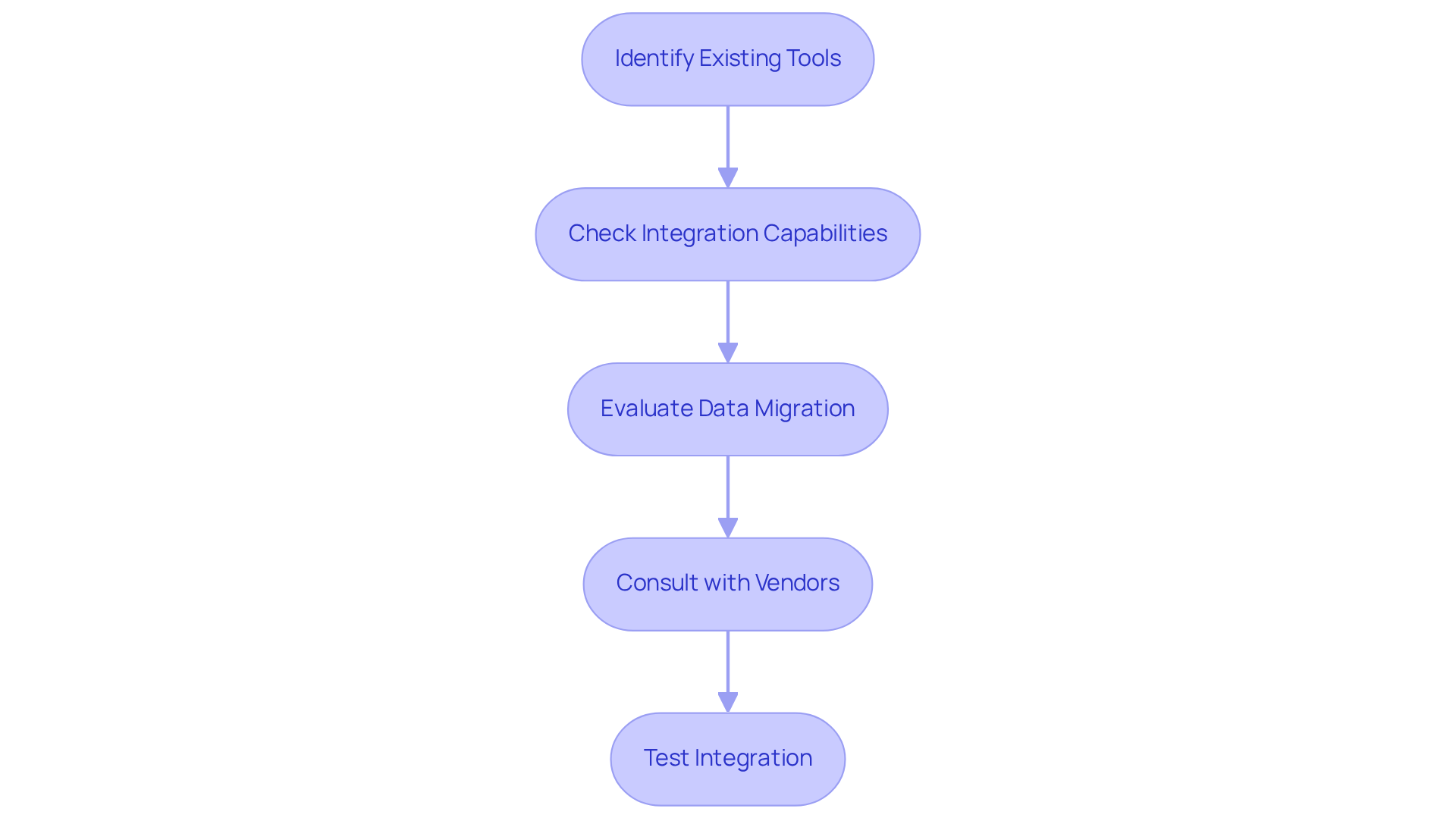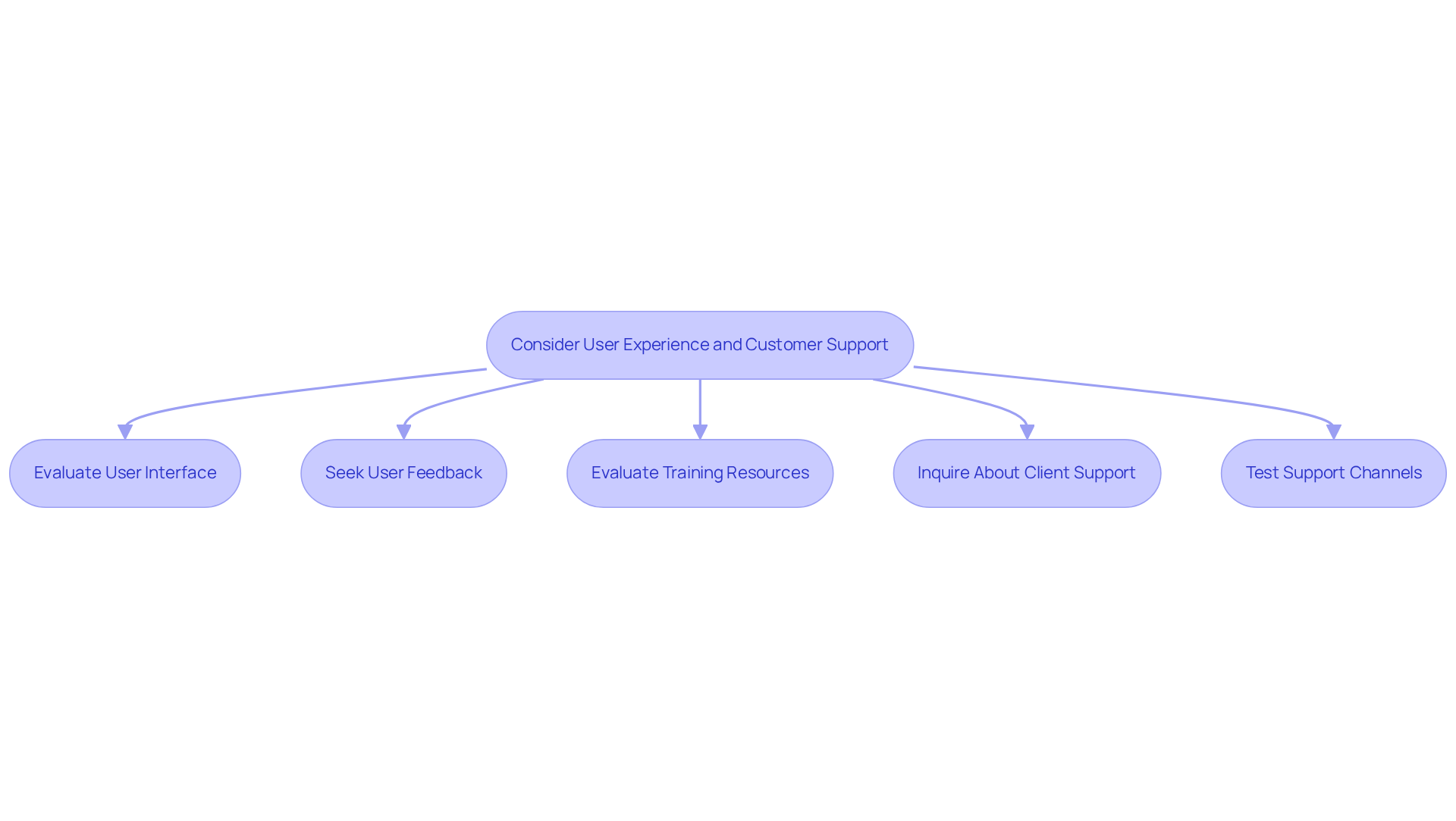Overview
The article delves into how businesses can effectively harness AI-powered flooring management software to elevate their operations. It highlights key features such as:
- Quoting tools
- Job management
- Client communication
- Inventory management
- Reporting capabilities
Moreover, it underscores the critical need to assess software compatibility, integration options, user experience, and customer support. These considerations are paramount for maximizing efficiency and ensuring customer satisfaction in a competitive marketplace.
Introduction
The flooring industry is undergoing a transformative shift, with businesses increasingly adopting AI-powered management software to streamline operations and elevate client satisfaction. By leveraging this technology, companies can unlock numerous advantages, including:
- Enhanced quoting accuracy
- Efficient job management
- Robust inventory tracking
However, with a plethora of software options available, how can businesses ensure they choose the right solution tailored to their unique needs and that maximizes productivity? This article explores the essential features, compatibility assessments, integration strategies, and user experience considerations that will empower flooring companies to effectively implement AI-powered flooring management software.
Identify Essential Features of AI Flooring Software
To effectively oversee your surface business, utilizing AI-powered flooring management software and recognizing key attributes that will enhance your operations is vital. Consider the following functionalities:
- Quoting Tools: The software must enable the swift generation of accurate and customizable quotes. Look for features that allow input of various flooring materials and labor costs, ensuring precise client estimates. This capability is crucial, as accurate quoting can significantly . In fact, generative AI has been shown to increase business productivity by 60-70%, making efficient quoting tools even more critical.
- Job Management: Effective job management is essential for tracking projects from initiation to completion. The software should facilitate scheduling, task assignments, and progress monitoring to ensure timely project delivery. This functionality streamlines operations and enhances overall efficiency.
- Client Communication: A built-in communication tool can streamline interactions with clients, allowing for easy updates, feedback, and approvals. Seek options that support email notifications and messaging, which can enhance satisfaction and engagement. As Jim Augustus Armstrong, founder of Flooring Success Systems, states, "The future isn’t AI replacing humans—it’s AI enhancing how you serve clients."
- Inventory Management: Effective inventory tracking is crucial for maintaining stock levels and managing supplies. The application should aid in reordering materials and monitoring usage across projects, helping to prevent delays and ensuring resources are available when needed.
- Reporting and Analytics: Choose a program that offers insights into your company's performance through detailed reports on sales, job expenses, and customer satisfaction metrics. This data can guide strategic decisions and identify areas for improvement, ultimately driving growth. The collaboration between Flooring OS and Estimat-All demonstrates how AI can improve estimation precision and efficiency, highlighting a successful application of these tools in the industry.
By concentrating on these attributes, you can ensure that the AI-powered flooring management software you choose will significantly enhance your operational efficiency, preparing you for success in a competitive marketplace.

Evaluate Software Compatibility with Business Needs
To ensure that the AI flooring software you choose aligns with your business needs, follow these steps:
- Assess Current Processes: Begin by documenting your existing workflows, including quoting, job management, and client communication. Identify pain points or inefficiencies that the new system should address, such as delays in quoting or challenges in client interactions.
- Define Key Requirements: Based on your evaluation, create a comprehensive list of essential features and functionalities that the application must support. This could include specific reporting capabilities, integration with existing tools, or mobile access to enhance on-the-go management.
- Conduct a Needs Analysis: Engage your team in discussions to gather input on their requirements from the application. This collaborative approach ensures that the selected solution meets the needs of all stakeholders, fostering buy-in and facilitating smoother implementation. Consulting with industry veterans can also provide valuable insights into the best technological solutions available.
- Research application options by looking for application solutions that explicitly state their compatibility with flooring industry needs, especially those utilizing AI-powered flooring management software. Examine evaluations and case studies to determine how other companies have effectively adopted the system, focusing on those that emphasize enhancements in efficiency and precision. For example, QFloors has been acknowledged for its high customer satisfaction, underscoring the importance of selecting the right program.
- Request Demos: Before making a final decision, request demonstrations of the application. This hands-on experience will assist you in determining whether the program can effectively support your business processes, allowing you to in real-world situations. As noted by industry specialists, the right applications empower floor-covering retailers to operate more effectively and provide improved client service.
By thoroughly assessing compatibility, you can choose a system that enhances your operations rather than complicating them, ultimately leading to improved productivity and customer satisfaction.

Assess Integration Options with Existing Tools
To maximize the benefits of your AI flooring software, consider the following steps to assess integration options:
- Identify Existing Tools: Compile a comprehensive list of all applications and tools currently utilized in your business, including accounting applications, CRM systems, and project management tools.
- Check Integration Capabilities: Investigate whether the AI application supports integration with your current tools. Look for APIs or built-in integrations that facilitate seamless data sharing between systems. Notably, 56% of flooring industry professionals consider a fully integrated technology suite 'very important' for streamlining operations, underscoring the significance of this step.
- Evaluate Data Migration: Assess how data will be transferred from your current systems to the new application. Ensure that the application offers robust assistance for data transfer to prevent the loss of critical information. Citing successful data transfer instances from other companies in the industry can provide valuable insights into best practices.
- Consult with Vendors: Engage with application vendors to inquire about their integration options. Request case studies or examples showing how other companies in the industry have successfully integrated their systems. It's essential to consider the trend towards preferring a single end-to-end technology vendor over multiple third-party tools, as this can simplify the integration process.
- Test Integration: If possible, carry out a trial run of the integration process to pinpoint potential problems before fully committing to the application. This step will help you understand the the new system into your existing workflows. Furthermore, assessing the cost-effectiveness of integration alternatives is essential, as 74% of businesses in the industry prioritize cost when choosing technology solutions.
By thoroughly assessing integration options, you can ensure that your new system enhances your existing operations, streamlining processes and improving overall efficiency.

Consider User Experience and Customer Support
When selecting AI solutions for surfaces, it is crucial to emphasize user experience and customer assistance. To guide your decision-making process, consider the following key guidelines:
- Evaluate User Interface: Opt for a program featuring an intuitive and easy-to-navigate interface. A user-friendly design minimizes the learning curve, facilitating quicker team adoption and enhancing productivity.
- Seek : Investigate evaluations and testimonials from fellow industry professionals to gauge their experiences with the application’s usability. Pay close attention to comments regarding ease of use and any challenges encountered, as these insights can significantly inform your decision. Notably, companies such as ABC Flooring Inc. have reported a 30% rise in client satisfaction after adopting flooring applications, underscoring the positive impact of effective user feedback systems.
- Evaluate Training Resources: Ensure that the provider offers comprehensive training materials, including tutorials, webinars, or documentation. Robust training resources can greatly accelerate your team's onboarding process. For instance, XYZ Flooring Company experienced enhanced project management and client satisfaction after utilizing such resources, illustrating the tangible benefits of proper training.
- Inquire About Client Support: Investigate the level of support available from the software vendor. Look for options such as live chat, phone support, and email assistance. An attentive support team is essential for swiftly addressing issues, leading to smoother operations and greater client satisfaction. Additionally, incorporating self-help options in client service can reduce user reliance on support, thereby enhancing the overall user experience.
- Test Support Channels: Before finalizing your decision, engage with the support channels by posing questions or seeking assistance. This interaction will provide insight into their responsiveness and commitment to user support. As noted by Shivani Dubey, assessing user experience and client feedback is vital for understanding how effectively the application meets user requirements.
By thoughtfully considering user experience and customer support, you can select flooring management software that not only fulfills your operational needs but also boosts overall team productivity and enhances customer satisfaction.

Conclusion
In the realm of flooring management, leveraging AI-powered software is no longer just an option; it is a necessity for businesses aiming to enhance operational efficiency and client satisfaction. By focusing on essential features such as quoting tools, job management, and effective communication, businesses can streamline processes and position themselves for success in a competitive landscape.
Selecting the right flooring management software involves crucial steps:
- Assessing compatibility with existing operations
- Evaluating integration options
- Prioritizing user experience and customer support
Each of these elements is vital in ensuring that the software meets current business needs and adapts to future challenges. The emphasis on data-driven insights and collaborative decision-making underscores the importance of a thoughtful approach to software selection.
Ultimately, integrating AI in flooring management presents a transformative opportunity. Embracing these advanced tools enables businesses to improve internal processes and enhance the overall customer experience. Investing in the right AI-powered flooring management software is not merely about keeping pace with technology; it is about laying a foundation for sustainable growth and innovation in the flooring industry.
Frequently Asked Questions
What are the essential features of AI flooring management software?
Essential features include quoting tools, job management, client communication, inventory management, and reporting and analytics.
Why are quoting tools important in flooring software?
Quoting tools are crucial as they enable the swift generation of accurate and customizable quotes, reducing lost sales opportunities and significantly improving business productivity.
How does job management functionality benefit flooring businesses?
Job management functionality helps track projects from initiation to completion, facilitating scheduling, task assignments, and progress monitoring, which enhances overall efficiency and ensures timely project delivery.
What role does client communication play in flooring management software?
Built-in communication tools streamline interactions with clients, allowing for easy updates, feedback, and approvals, which can enhance client satisfaction and engagement.
How does inventory management contribute to flooring operations?
Effective inventory management aids in tracking stock levels and managing supplies, helping to prevent delays by ensuring that resources are available when needed.
What is the significance of reporting and analytics in flooring software?
Reporting and analytics provide insights into company performance through detailed reports on sales, job expenses, and customer satisfaction, guiding strategic decisions and identifying areas for improvement.
How can AI enhance the flooring business according to the article?
AI can enhance the flooring business by improving estimation precision and efficiency, as demonstrated by successful collaborations in the industry, ultimately driving growth and operational efficiency.




